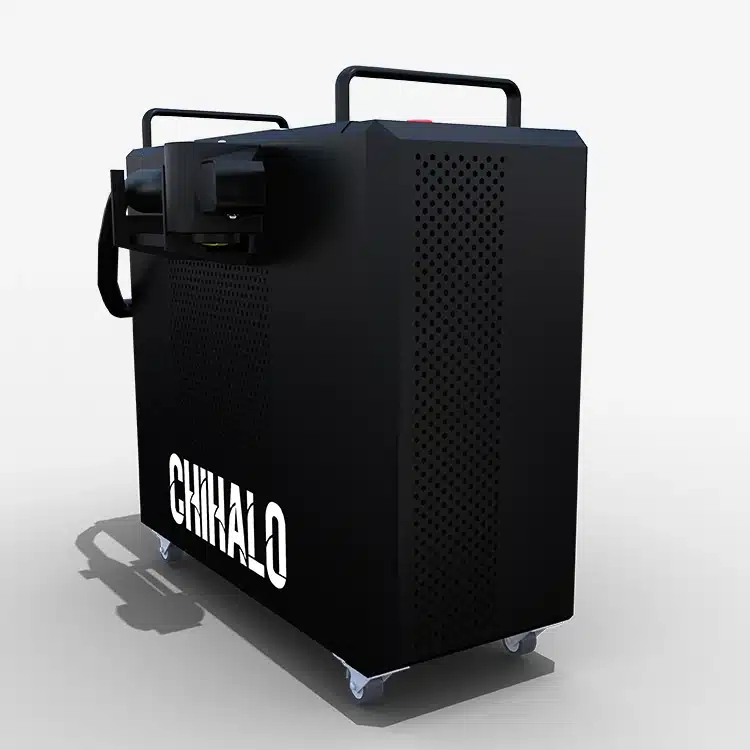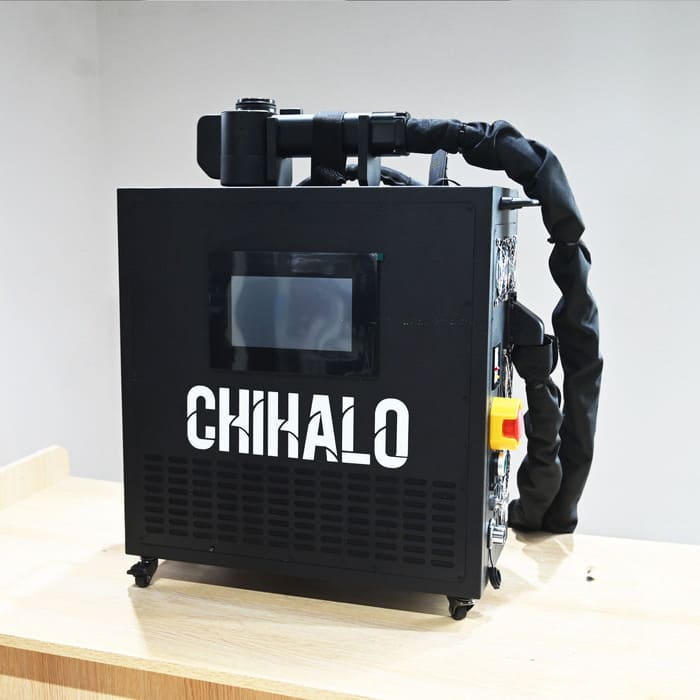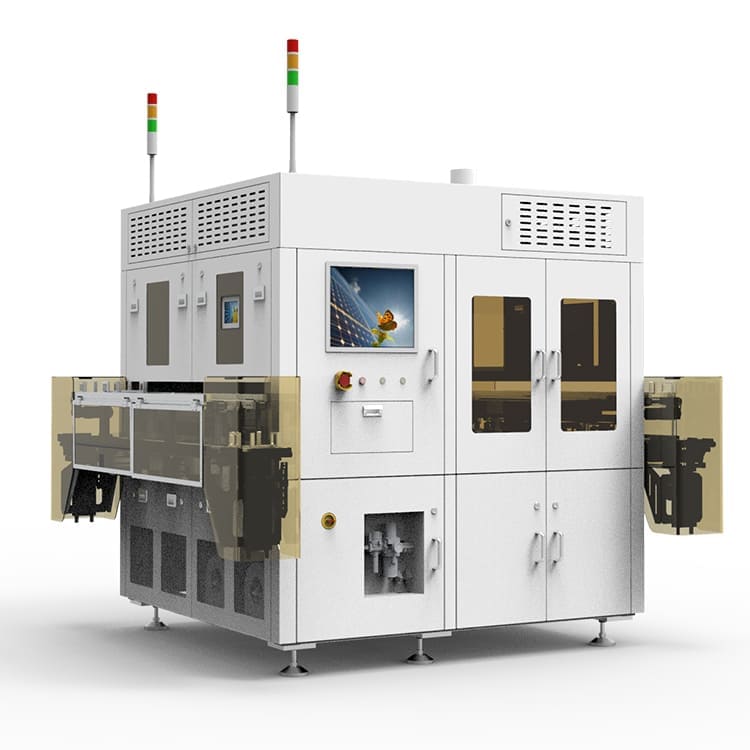1KW-3KW CW Laser Metal Cleaning Machine
Engineered for precision and efficiency, our 1KW-3KW continuous wave systems deliver unmatched performance for rust removal, paint stripping, and industrial surface treatment across diverse manufacturing applications.
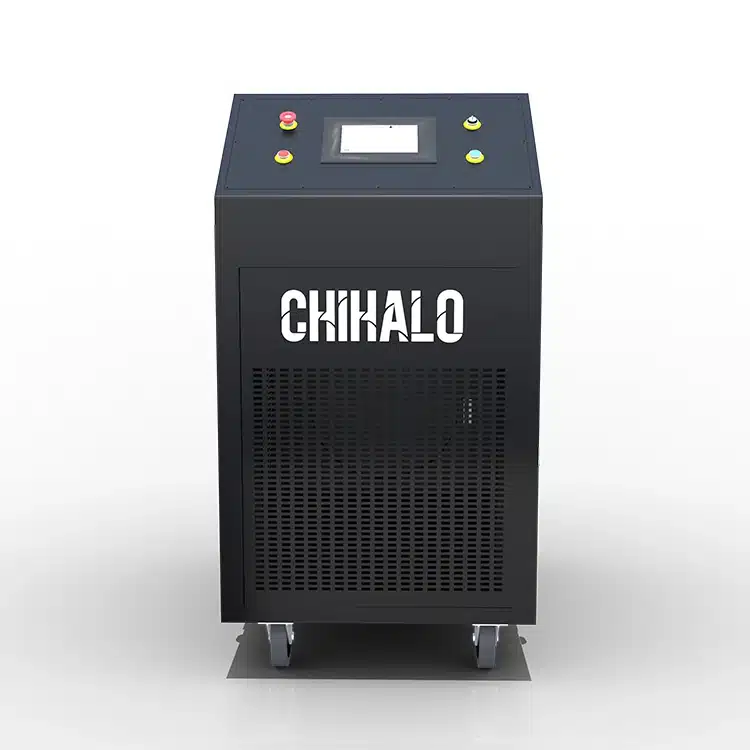
1. Technical Parameters
100W-500W MOPA Laser Metal Cleaning Machine: Complete Power Range & Specifications
|
Model
|
CHL-C1000-W
|
CHL-C1500-W
|
CHL-C2000-W
|
CHL-C3000-W
|
|---|---|---|---|---|
|
Operation Mode |
Continuous |
Continuous |
Continuous |
Continuous |
|
Laser Power |
1000W |
1500W |
2000W |
3000W |
|
Wavelength |
1080nm |
1080nm |
1080nm |
1080nm |
|
Fiber Core Diameter |
50um |
50um |
50um |
50um |
|
Beam Quality |
BPP≤0.5 |
BPP≤0.5 |
BPP≤0.5 |
BPP≤0.5 |
|
Pulse Range |
2~350ns |
30~500ns |
30~500ns |
30~500ns |
|
Fiber Cable |
10-20m |
10-20m |
10-20m |
10-20m |
|
Cooling |
Water Cooling |
Water Cooling |
Water Cooling |
Water Cooling |
|
Scaning Length |
<650mm |
<650mm |
<650mm |
<650mm |
|
Storage Temperature |
-10 ~60℃ |
-10 ~60℃ |
-10 ~60℃ |
-10 ~60℃ |
|
Work Temperature |
0 ~40℃ |
0 ~40℃ |
0 ~40℃ |
0 ~40℃ |
|
Machine Size |
860*550*1150mm |
860*550*1150mm |
860*550*1150mm |
860*550*1150mm |
|
Machine Weight |
180KG |
180KG |
200KG |
200KG |
|
Input Power |
220V 50Hz |
220V 50Hz |
220V 50Hz |
380V 50Hz |
|
Power Consumption |
4.5KW |
5KW |
11KW |
15KW |
2. What Is a CW Laser Metal Cleaning Machine?
A continuous wave laser metal cleaning machine represents the pinnacle of industrial surface treatment technology, utilizing focused laser beams to remove contaminants from metal surfaces with unprecedented precision.
When we choose a laser metal cleaning machine, it’s very important to decide if take CW or Pulse type, because their cleaning effiency, price and surface effect are very different!
How Continuous Wave (CW) Laser Cleaner Works?
CW laser metal cleaning machines generate a steady, continuous beam of coherent light at 1064nm wavelength, optimized for metal surface interaction. When the laser beam contacts contaminated metal surfaces, it selectively heats and vaporizes rust, paint, oxide layers, and other contaminants while leaving the underlying metal substrate completely unaffected. This selective absorption occurs because contaminants typically have different optical properties than the base metal, allowing for precise material removal.
Key Differences Between CW and Pulsed Lasers
CW Laser Metal Cleaning Machine
Continuous wave laser cleaning machines offer distinct advantages over pulsed laser systems for metal cleaning applications. CW lasers provide steady, consistent power delivery that excels at removing heavy rust, thick paint layers, and stubborn contaminants that require sustained energy application. This makes them ideal for industrial applications where thorough, deep cleaning is essential.
In contrast, pulsed laser systems deliver energy in short bursts, making them better suited for delicate applications requiring minimal heat input. CW systems achieve superior cleaning speeds on metal surfaces while maintaining excellent control over the cleaning process, making them the preferred choice for automotive, shipbuilding, and heavy manufacturing applications.
3. Price Range and ROI Considerations
CHL-C1000-W:
Starting from $5,000-85,00
- Ideal for: Small to medium fabrication shops, maintenance operations, specialty cleaning applications
- Typical ROI: 8-14 months through labor savings and consumable elimination
CHL-C2000-W:
Starting from $6,000-85,00
- Ideal for: Medium to large manufacturing operations, automotive applications, general industrial cleaning
- Typical ROI: 8-14 months through productivity improvements and waste elimination
CHL-C3000-W:
Starting from $8,000-115,00
- Ideal for: Heavy industrial applications, shipbuilding, large-scale surface preparation
- Typical ROI: 8-14 months through labor savings and consumable elimination
ROI calculations should include labor cost savings, consumable elimination, waste disposal cost reduction, and improved quality benefits. Many customers achieve payback periods shorter than calculated estimates through unexpected productivity improvements and additional applications discovered after installation.
What Is Included with Your Purchase?
Complete system packages include all components necessary for immediate operation and long-term success.
Standard Package Includes:
- Complete laser cleaning system with selected power level
- Comprehensive operator training online
- OD 8+ Laser Goggles 2 Pairs
- Protective Lens 5 Pieces
- F-theta lens 2 Sets
- Multi-language Software with LOGO and Pre-programmed parameters
- 2-year comprehensive warranty
- Technical documentation and operating manuals
- Remote diagnostic capability and initial setup support
- Air Box Package
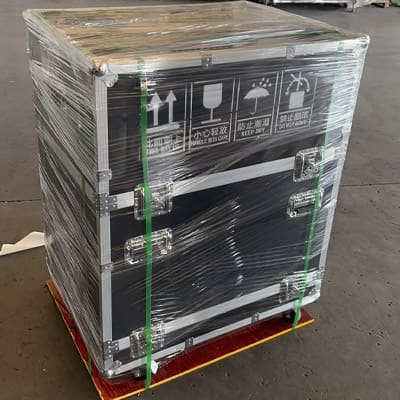
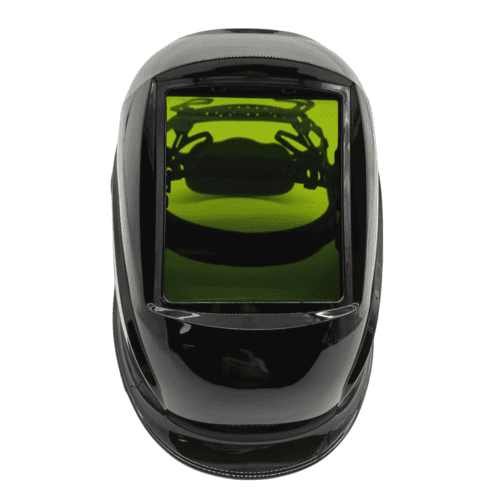
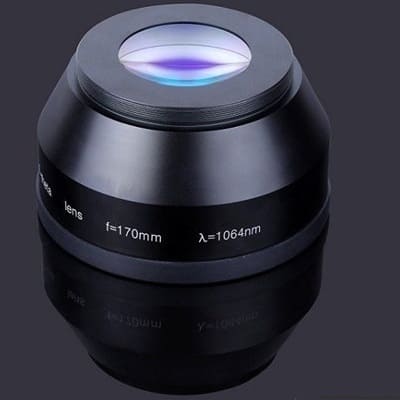
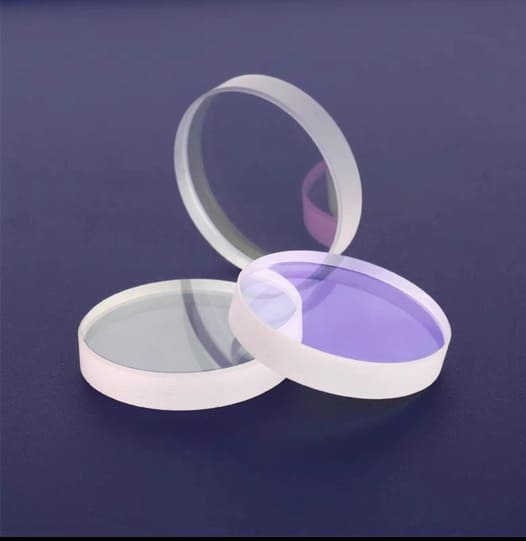
Optional Upgrades Available:
- Advanced safety enclosures and interlocks
- Automated material handling systems
- Custom application programming
- Extended warranty and service packages
- Additional operator training and certification
- Specialized scanning heads for unique applications
4. Core Advantages of CW 1KW-3KW Laser Cleaning
The 1KW-3KW Laser Metal Cleaning Machine range represents the optimal balance between cleaning capability, energy efficiency, and operational flexibility for most industrial metal cleaning applications.
Consistent Power for Deep Rust & Paint Removal
CW laser metal cleaning machines excel at removing heavy rust accumulation, thick industrial coatings, and stubborn contaminants that challenge traditional cleaning methods. The continuous power delivery ensures consistent energy application across large surface areas, achieving cleaning speeds of 5-25 m²/hour depending on contamination level and desired surface finish quality.
Safety and Substrate Protection Benefits
Advanced CW Laser Metal Cleaning Machine incorporate multiple safety features that protect both operators and workpieces. The non-contact cleaning process eliminates mechanical damage risks associated with abrasive methods, while precise power control prevents substrate overheating or thermal damage.
Energy Efficiency and Environmental Impact
CW laser metal cleaning machines deliver exceptional environmental benefits compared to traditional cleaning methods. The process generates no chemical waste, requires no consumable materials beyond electricity, and produces minimal secondary waste that can be easily collected through standard fume extraction systems.
5. CW Laser vs Traditional Metal Cleaning Methods
Comprehensive comparison analysis demonstrates CW laser metal cleaning’s superior performance across multiple evaluation criteria, supporting informed decision-making for industrial cleaning investments.
Laser vs Sandblasting: Cost, Speed & Quality Comparison
CW laser cleaning effectively overcomes the key limitations of traditional sandblasting—such as ongoing consumable costs, waste disposal, and potential substrate damage—while providing higher cleaning quality and better environmental compliance.
Although the initial investment is higher, laser cleaning proves more cost-effective long-term. It requires no consumables, minimizes infrastructure needs, and reduces operating costs by 40-60% over five years compared to sandblasting.
In terms of quality, laser cleaning removes contaminants precisely without altering the substrate’s dimensions or geometry. It also allows fine control over surface roughness, ensuring ideal preparation for subsequent treatments.
Laser vs Chemical Cleaning: Safety & Environmental Impact
Chemical cleaning methods involve significant safety and environmental risks, including handling hazardous materials, producing toxic waste, and meeting strict regulatory standards. These processes also expose workers to chemical contact, inhalation, and skin hazards, necessitating extensive protective gear and safety measures.
In contrast, laser cleaning offers clear environmental benefits. It produces minimal waste, and any resulting particles are easily managed with standard ventilation. Air quality tests confirm that laser cleaning emits far fewer pollutants than chemical methods.
Laser cleaning also simplifies regulatory compliance by eliminating the need to store, handle, or dispose of hazardous chemicals. With many regions now restricting or banning traditional chemical cleaners, laser technology provides a safer and more sustainable long-term solution.
Laser vs Mechanical Grinding: Precision & Material Preservation
Mechanical grinding and wire brushing often remove excess base material and generate heat, which can alter metal properties. They are also poorly suited for complex surfaces and typically demand heavy manual labor.
In contrast, laser cleaning offers high precision and repeatability. Unlike grinding, which can result in uneven material loss, laser cleaning ensures consistent results across large areas with accurate control over depth and intensity.
Moreover, laser cleaning uniquely preserves the original substrate dimensions and integrity by only removing contaminants. This makes it especially valuable for precision components where dimensional accuracy is essential.
6. FAQ about Laser Metal Cleaning Machine
Complete Q&A Section
A laser metal cleaning machine uses focused laser beams to remove contaminants like rust, paint, and oxide layers from metal surfaces without damaging the underlying material. The process relies on selective heating and vaporization of surface contaminants while preserving the base metal's integrity and dimensional accuracy.
CW lasers emit constant, steady power that heats and vaporizes surface contaminants while the substrate remains unaffected due to different absorption rates. The continuous energy delivery enables efficient removal of heavy rust, thick paint, and stubborn contaminants that require sustained power application for complete elimination.
CW lasers provide consistent power for heavy-duty cleaning tasks like thick rust and industrial coatings, while pulsed lasers deliver energy in bursts for more delicate applications. CW systems excel at high-productivity cleaning operations where thorough contamination removal is required, making them ideal for industrial manufacturing environments.
CW laser cleaning machines effectively clean steel, stainless steel, aluminum, copper, brass, cast iron, and many other metal alloys. The systems can also handle certain non-metallic materials like stone and concrete with appropriate parameter adjustments. Each material type has optimized cleaning parameters for maximum effectiveness and substrate protection.
Yes, CW lasers excel at removing heavy rust accumulation, thick paint layers, industrial coatings, and other stubborn contaminants. The continuous power delivery ensures complete contamination removal even on heavily corroded surfaces, achieving cleaning results superior to traditional methods while preserving substrate integrity.
Most metals including ferrous and non-ferrous materials respond well to laser cleaning with proper parameter optimization. Common applications include carbon steel, stainless steel, aluminum alloys, copper, brass, titanium, and specialized alloys used in aerospace and marine applications.
Systems comply with international laser safety standards including IEC 60825, and CE marking requirements. Essential safety measures include proper laser safety training, appropriate protective equipment, controlled access areas, and compliance with local laser safety regulations and workplace safety standards.
Critical safety features include laser safety interlocks, emergency stop systems, protective enclosures, beam containment systems, key switches for authorized operation, warning labels and indicators, and integration with facility safety systems. Class 1 enclosed systems provide the highest level of operator protection.
Primary industries include automotive manufacturing and restoration, shipbuilding and marine maintenance, aerospace component preparation, oil and gas equipment maintenance, power generation facility maintenance, general metal fabrication, heritage restoration, and precision manufacturing operations requiring high-quality surface preparation.
We provide comprehensive video libraries showcasing real-world applications, documented case studies with measurable results, virtual demonstrations via video conferencing, and on-site demonstrations for qualified prospects. Our technical team can arrange customized demonstrations focusing on your specific applications and requirements.
No, when properly configured and operated, CW laser systems selectively remove only surface contaminants while preserving the base metal's integrity. Advanced parameter control and real-time monitoring ensure optimal cleaning without substrate damage, dimensional changes, or metallurgical property alterations.
Properly operated CW laser cleaning systems are specifically designed to avoid substrate damage through precise parameter control and selective energy absorption. The cleaning process removes only contaminants while maintaining original surface geometry, dimensional accuracy, and material properties.
1KW systems handle light rust, thin paint, and precision cleaning applications. 2KW systems provide optimal performance for general industrial cleaning, moderate rust, and most automotive applications. 3KW systems excel at heavy-duty applications including thick industrial coatings, heavy rust accumulation, and high-volume production requirements.
Cleaning width varies from 10-300mm depending on the system configuration and application requirements. Cleaning speeds range from 2-25 m²/hour based on contamination level, desired surface quality, and power level. Higher power systems achieve greater speeds while maintaining excellent cleaning quality.
Operating costs typically range from $2-4 per hour including electricity consumption and minimal maintenance requirements. The consumable-free operation eliminates ongoing material costs associated with traditional cleaning methods, while preventive maintenance involves primarily optical component cleaning and system inspections.
CW laser cleaning systems operate at approximately $2-4 per hour including electricity costs, with no consumables required unlike sandblasting or chemical methods. Maintenance costs are minimal due to the systems' robust design and long component life, resulting in total operating costs 40-60% lower than traditional alternatives.
What kind of personal protective equipment (PPE) is needed for operating?
Operators require basic laser safety training (typically 2-3 days) covering safe operation procedures, parameter adjustment, and routine maintenance tasks. Maintenance involves periodic optical component cleaning, cooling system inspection, and software updates, most of which can be performed by trained operators.
Operation involves simple touchscreen controls with pre-programmed parameters for common applications. Daily maintenance includes basic cleaning and system checks, while periodic maintenance involves optical component cleaning, cooling system inspection, and calibration verification. Most tasks can be performed by operators with basic training.
Important features include adjustable power output for different applications, variable beam shaping and scanning patterns, robust cooling systems for continuous operation, comprehensive safety systems, user-friendly controls with pre-programmed parameters, remote diagnostic capability, and reliable technical support from experienced manufacturers.

